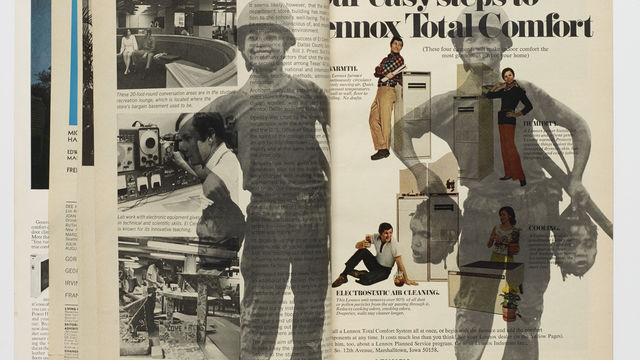
Robert Heinecken’s Layers
Throughout his career, Robert Heinecken produced works that invariably incorporated photographic imagery. In the early 1960s he founded UCLA’s photography department, one of the first of its kind, and remained closely involved in professional photographic associations. Yet he did not label himself a photographer, preferring instead “photographist” and “paraphotographer” to describe his artistic activities. These terms meld recognizable words into hybrid, provocative concepts. In so doing, they mirror Heinecken’s work with found photographic images—from magazines, to newspapers, to mail order pornography—which he spliced and layered together in a working process that, as he described retrospectively in 1996, “is basically collage.”
Heinecken in fact never had an allegiance to a specific medium. He had primarily studied printmaking and design while at UCLA in the late 1950s, but as the decade turned and he became a young lecturer (and promptly professor), his attention shifted to photography—a field that at the time still struggled to be taken seriously in fine art circles. His first mature works in 1962 involved straightforward photographic figural studies featuring marked contrasts of light and dark, which result in the abstraction and fragmentation of his models’ bodies. By 1964, though, Heinecken had embarked on a new series that took mass media as both its source and subject. For Are You Rea (1964-68), the artist treated magazine pages as negatives, in essence, developing them so as to allow each side of the original page to bleed through to the other. The unexpected combinations that arose—surprising for their aesthetic and sociological revelations alike—inaugurated Heinecken’s adoption of juxtaposition and layering as key elements to his artistic process.

In 1968 and 1969, Heinecken produced a group of works that constituted actual collages, with real layers, and were also his most overtly political works to date. In V.N. Pin-Up, for example, cut fashion advertisements are joined together with visual and textual evidence of the ravages of the Vietnam War, which he pulled from magazines such as Life as well as local newspapers. He laid a clear, thin sheet of Plexiglas upon the collage to add depth to the picture; and atop that, a transparent film portraying the up-lifted arms and curving body of a suggestively posed figure. As Heinecken describes in Heinecken Explains Heinecken, the source for this image was a company based in Hollywood that sent titillating (and explicit) photographic negatives through the mail to interested subscribers. The pin-up imposes its form onto the collaged magazine fragments beneath it, conflating notions of capitalism, sex, and violence. Despite the confusing and disturbing message, however, the object itself is visually appealing with its lush colors, hybrid materials, and physical dimensionality. Heinecken’s goal, if anything, was to provoke questioning in the mind of his viewers.

In the late 1960s and into the 1970s, the artist continued to exploit the potential of juxtaposition in his suites of manipulated magazines. He took numerous approaches to these cultural specimens. At times, he sutured together pages from magazines on a variety of subjects (home, fashion, sports, pornography, etc.) into perplexing and suggestive visual narratives. At other times he would cut holes within the pages of one magazine, revealing hidden relationships amidst the new layers he had created. A third tactic involved screen-printing one image systematically onto the successive pages of a Time or Bazaar issue, including a shocking photograph of a Viet Cong soldier smiling widely while carrying the severed heads of two enemies. At each page turn, Heinecken’s superimpositions interact with a different backdrop, generating new combinations and associations that use gruesome political realities to shatter the printed illusions of fashionability and consumerism.

Heinecken’s mixing of mediums, sources, and subject matter offers a critique of, and simultaneously indulges in, the fantasies that mass media provides its readers and viewers. Approaching his work with an eye towards collage—which at its core involves collecting, juxtaposing, and recombining found objects and images—gave Heinecken the freedom to push the practice and study of photography into new, multilayered terrains.
Claire de Dobay Rifelj is an L.A.-based writer and curator. She is currently completing her dissertation at New York University on collage practices in Los Angeles in the 1960s and 1970s.




